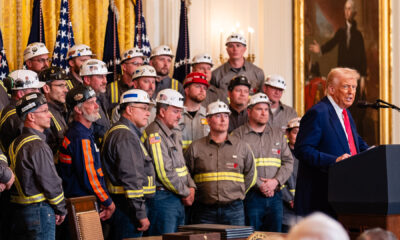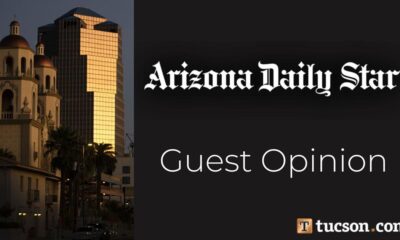Education
Federal Reserve Holds Interest Rates Steady Amid Economic Uncertainty

The Federal Reserve is expected to announce a continued pause on interest rate changes during its policy meeting, as economic indicators show mixed signals. This marks the fifth consecutive meeting where rates are likely to remain unchanged, despite ongoing pressure from President Donald Trump for significant cuts.
According to the payroll company ADP, private-sector hiring rebounded in July, with approximately 104,000 jobs added, contrasting sharply with the loss of 23,000 jobs in June. This reversal highlights a growing optimism among employers, particularly in sectors such as leisure, hospitality, finance, transportation, and construction. The ADP report, which analyzes payroll data from over 25 million businesses, is seen as a potential indicator of employment trends ahead of the official jobs report from the Bureau of Labor Statistics, scheduled for release soon.
As the stock market anticipates the Fed’s decision, futures indicate a modest upward trend. On Wednesday, Dow Jones futures remained flat, while S&P 500 futures rose by 0.1% and Nasdaq 100 futures gained 0.15%. This comes after a dip in the market where the S&P 500 fell 0.3% on the previous day, breaking a streak of six consecutive record highs.
Votes of Dissent Expected in Fed Meeting
This week’s Federal Reserve meeting may be one of the most contentious in decades. For over 30 years, decisions regarding interest rates have typically been unanimous. However, analysts predict that Christopher Waller and Michelle Bowman, both members of the Fed’s Board of Governors, may dissent against the decision to maintain rates. This would be the first time two governors have dissented simultaneously since 1993. Waller and Bowman have publicly advocated for the Fed to resume rate cuts, arguing that concerns regarding inflation from Trump’s tariffs should not hinder monetary policy adjustments.
Adding to the complexity, another governor, Adriana Kugler, will not be participating in the meeting due to personal reasons. President Trump has indicated plans to appoint a new Fed chair when Jerome Powell‘s term concludes in May 2026. Waller and Bowman are considered potential candidates for this position, alongside other figures such as Kevin Hassett, head of the National Economic Council, and former Fed governor Kevin Warsh.
Market Reactions and Future Projections
Investor expectations are primarily focused on how Fed Chair Jerome Powell will address the impact of tariffs on the economy, the extent of any dissent, and indications for potential future rate cuts. Analysts predict a steady stance on interest rates, with minimal chances for immediate cuts. Comments from various financial experts illustrate this sentiment:
– “The expectation for any rate cuts at this meeting is slim to none, even with the relentless pressure from President Trump,” stated Byron Anderson, head of fixed income at Laffer Tengler Investments.
– Christian Hoffmann, head of fixed income at Thornburg Investment Management, noted, “The Fed will hold rates steady for the fifth straight meeting and largely maintain existing signals about the policy outlook.”
There is speculation about a possible “conditional” rate cut in September if inflation shows signs of softening. James St. Aubin, CIO at Ocean Park Asset Management, commented that while no cuts are anticipated in July, the economic landscape could change in the coming months.
The Federal Reserve’s hesitation to lower rates this year stems from several factors. Economic uncertainty, driven by Trump’s fluctuating tariff policies, complicates forecasts. Additionally, inflation remains above the Fed’s 2% target, with recent readings indicating a 2.3% annual increase in May. The unemployment rate continues to stay low, further reducing the urgency for rate cuts.
President Trump’s strong advocacy for lower interest rates is rooted in the belief that such actions can stimulate economic growth. Lower rates generally result in reduced borrowing costs for consumers and businesses, potentially leading to increased spending. However, the Fed’s cautious approach is aimed at preventing inflation from escalating, particularly as tariffs could eventually lead to higher consumer prices.
In summary, as the Federal Reserve prepares for its upcoming decision, the balance between economic growth and inflation control remains a pivotal concern. Investors and analysts alike will be closely monitoring the results of this meeting and the subsequent economic indicators to gauge the central bank’s future direction.
-

 Technology5 months ago
Technology5 months agoDiscover the Top 10 Calorie Counting Apps of 2025
-

 Technology3 weeks ago
Technology3 weeks agoOpenAI to Implement Age Verification for ChatGPT by December 2025
-

 Health3 months ago
Health3 months agoBella Hadid Shares Health Update After Treatment for Lyme Disease
-

 Health3 months ago
Health3 months agoAnalysts Project Stronger Growth for Apple’s iPhone 17 Lineup
-

 Health4 months ago
Health4 months agoErin Bates Shares Recovery Update Following Sepsis Complications
-

 Technology5 months ago
Technology5 months agoDiscover How to Reverse Image Search Using ChatGPT Effortlessly
-

 Technology3 months ago
Technology3 months agoElectric Moto Influencer Surronster Arrested in Tijuana
-

 Technology5 months ago
Technology5 months agoMeta Initiates $60B AI Data Center Expansion, Starting in Ohio
-

 Technology2 months ago
Technology2 months agoDiscover 2025’s Top GPUs for Exceptional 4K Gaming Performance
-

 Technology5 months ago
Technology5 months agoRecovering a Suspended TikTok Account: A Step-by-Step Guide
-

 Health5 months ago
Health5 months agoTested: Rab Firewall Mountain Jacket Survives Harsh Conditions
-

 Lifestyle5 months ago
Lifestyle5 months agoBelton Family Reunites After Daughter Survives Hill Country Floods





















